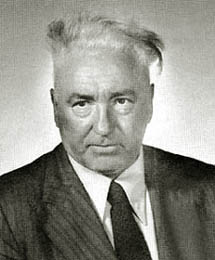
Wilhelm Reich (March 24, 1897–November 3, 1957) was an Austrian-American psychiatrist, psychoanalyst, and author, who was trained in Vienna by Sigmund Freud.
In the 1930s, Reich claimed to have discovered a physical energy, which he called "orgone," and which he said was contained in the atmosphere and in all living matter. He developed instruments — orgone accumulators — to detect and harness the energy, which he said could be used to treat illnesses like cancer. His views were not accepted by the mainstream scientific community.
When his Mass Psychology of Fascism, published in 1933, was banned by the Nazis, Reich realized he was in danger; he moved to the United States in 1939, where he continued his orgone research. In 1947, following a series of articles about orgone in The New Republic and Harpers, the U.S. Food and Drug Administration (FDA) began an investigation into Reich's claims about orgone therapy, and won an injunction against its promotion as a medical treatment. Charged with contempt of court for violating the injunction, Reich conducted his own defense, which involved sending the judge all his books to read. He was sentenced to two years' imprisonment.
In August 1956, several tons of his publications were burned by the FDA. He died of heart failure in jail just over a year later, one day before he was due to apply for parole.
Early life and career
Wilhelm Reich was born in Dobrzanica, a village near Lemberg, then part of the Austro-Hungarian Empire, now in the Ukraine. His parents, Leon Reich, a prosperous farmer, and Cecilia Roniger, were Jewish. Shortly after his birth, the family moved south to a farm in Jujinetz, near Chernivtsi, Bukovina. He attributed his later interest in the study of sex and the biological basis of the emotions to his upbringing on his father's farm where, as he later put it, the "natural life functions" were never hidden from him. He was taught at home until he was 13 when his mother committed suicide after being discovered having an affair with Reich's tutor.
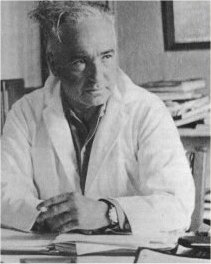
Reich had to flee his home shortly after his father's death in 1914, when the Russian army invaded. In his Passion of Youth, he wrote: "I never saw either my homeland or my possessions again. Of a well-to-do past, nothing was left."
He joined the Austrian Army, serving from 1915-18, for the last two years as a lieutenant. In 1918, when the war ended, he entered the medical school at the University of Vienna. As an undergraduate, he was drawn to the work of Sigmund Freud, who became aware of Reich's work in 1919 when Reich organized a seminar on sexology. Reich was accepted for membership of the Vienna Psychoanalytic Association in October 1920 at the age of 23. According to the Wilhelm Reich Museum's biography, he was allowed to complete his six-year medical degree in four years because he was a war veteran, and received his M.D. in July 1922. He worked in Internal Medicine at University Hospital, Vienna, and studied neuropsychiatry from 1922-24 at the Neurological and Psychiatric Clinic under Professor Wagner-Jauregg, who received the Nobel Prize in Medicine in 1927.
The early development of orgone therapy
In 1922, Reich set up private practice as a psychoanalyst, and became first clinical assistant, and later vice-director, at Freud's Polyanalytic Polyclinic. He joined the faculty of the Psychoanalytic Institute in Vienna in 1924, and conducted research into the social causes of neurosis. It was at the Vienna Psychoanalytic Association that Reich met Annie Pink, a fellow analyst-in-training. They married, and had their first daughter, Eva, in 1924 and a second daughter in 1928, but Reich was unable to control his interest in other women. The marriage was not a happy one, and did not last.
Reich developed a theory that the ability to feel sexual love depended on a physical ability to make love with what he called "orgastic potency." He attempted to "measure" the male orgasm, noting that four distinct phases occurred physiologically: first, the psychosexual build-up or tension; second. the tumescence of the penis, with an accompanying "charge," which Reich measured electrically; third, an electrical discharge at the moment of orgasm, and fourth, the relaxation of the penis. He believed the force that he measured was a distinct type of energy present in all life forms. He called it "orgone."
He was a prolific writer for psychoanalytic journals in Europe, and his book Character Analysis brought forth a small revolution in the practice of psychoanalysis itself, and is still used today as a textbook for analytically-oriented classes in medical schools. Originally psychoanalysis was focused on the treatment of neurotic symptoms. Character Analysis was a major step in the development of what today would be called ego psychology. In Reich's view a person's entire character (or personality), not only individual symptoms, could be looked at and treated as a neurotic phenomenon. The book also introduced Reich's theory of "body armoring." He argued that unreleased psychosexual energy could produce actual physical blocks within muscles and organs, and that these act as a "body armor," preventing the release of the energy. An orgasm was one way to break through the armor. These ideas developed into a general theory of the importance of a healthy sex life to overall well-being, a theory compatible with Freud's views.
Reich agreed with Freud that sexual development was the origin of mental disorder. They both believed that most psychological states were dictated by unconscious processes; that infant sexuality develops early but is repressed, and that this has important consequences for mental health. They believed that morality is a repression of the sexuality of individuals imposed on them as they move from childhood to maturity. Reich argued that the source of sexual repression was bourgeois morality and the socio-economic structures that produced it. As sexual repression was the cause of the neuroses, the best cure would be to have an active, guilt-free sex life. He argued that such a liberation could come about only through a morality not imposed by a repressive economic structure.
Reich employed an unusual therapeutic method. He used touch to accompany the talking cure, taking an active role in sessions, feeling his patients' chests to check their breathing, repositioning their bodies, and sometimes requiring them to remove their clothes, so that men were treated wearing shorts and women in bra and panties. These methods caused a split between Reich and the rest of the psychoanalytic community.
In 1930, he moved his practice to Berlin. His best-known book, The Sexual Revolution, was published at this time in Vienna.
In the same year, The Mass Psychology of Fascism was published, in which Reich categorized fascism as a symptom of sexual repression. The book was banned by the Nazis when they came to power. Reich was expelled from the International Psychological Association in 1934 for political militancy. German newspapers started attacking him as a womanizer, a communist, and a Jew who advocated free love. He realized he was in danger and hurriedly left Germany disguised as a tourist on a ski trip to Austria. He spent some years in Denmark, Sweden, and Norway, before leaving for the U.S. in 1939.
The bion experiments
From 1934-37, based for most of the period in Oslo, Reich conducted experiments seeking the origins of life. He examined protozoa, single-celled creatures with nuclei that, like animals, display mobility and heterotrophy, meaning they require organic matter to obtain carbon for growth. He grew cultured vesicles using grass, beach sand, iron, and animal tissue, boiling them, adding potassium and gelatin. Having heated the materials to incandescence with a heat-torch, he noted bright, glowing, blue vesicles, which, he claimed, could be cultured, and which gave off an observable radiant energy, which he called orgone. He named the vesicles "bions" and believed they were a rudimentary form of life, or halfway between life and non-life. When he poured the cooled mixture onto growth media, bacteria were born. Reich's The Bion Experiments on the Origin of Life was published in Oslo in 1938, leading to attacks in the press that he was a "Jew pornographer" who was daring to meddle with the origins of life.
T-bacilli
In 1936, in Beyond Psychology, Reich wrote that:
Since everything is antithetically arranged, there must be two different types of single-celled organisms: (a) life-destroying organisms or organisms that form through organic decay, (b) life-promoting organisms that form from inorganic material that comes to life.
This idea led Reich to believe he had found the cause of cancer. He called the life-destroying organisms "T-bacill," with the T standing for Thanatos, Greek for death. He described in The Cancer Biopathy how he had found them in a culture of rotting cancerous tissue obtained from a local hospital. He wrote that T-bacilli were formed from the disintegration of protein. He claimed they were 0.2 to 0.5 micrometre in length, shaped like lancets, and when injected into mice, they caused inflammation and cancer. He concluded that when orgone energy diminishes in cells, through ageing or injury, the cells undergo "bionous degeneration" or death. At some point, the deadly T-bacilli start to form in the cells. Death from cancer, he believed, was caused by an overwhelming growth of the T-bacilli.
Orgone accumulators and cloudbusters
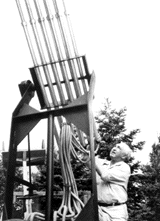
In March 1938, Hitler annexed Austria. Reich's ex-wife and daughters had already left for the U.S., and in August 1939, Reich sailed out of Norway on the last boat to leave before the war began. He settled in Forest Hills, Long Island, and in 1946, married Ilse Ollendorf, with whom he had a son, Peter who later helped Kate Bush with her video cloadbusting.
Reich was one of the first of the European socialists to break ranks completely with the Communist Party; for example, in his book Mass Psychology of Fascism, which he wrote after a trip to Russia, he identified communism as "Red Fascism".
In 1940, Reich built boxes — orgone accumulators — to concentrate orgone energy in the atmosphere, some for lab animals, and some large enough for a human being to sit inside. He stated that orgone is a type of primordial cosmic energy, blue in color, which is omnipresent and responsible for such things as weather, the color of the sky, gravity, the formation of galaxies, and the biological expressions of emotion and sexuality. Composed of alternating layers of ferrous metals and insulators with a high-dielectrical constant, his orgone accumulators had the appearance of a large hollow "capacitor". He believed that sitting inside the box might provide a treatment for cancer and other illnesses. It was the construction of these boxes that caught the attention of the press, and wild rumors spread that they were "sex boxes" which caused uncontrollable erections.
Reich also designed a "cloudbuster" with which he could manipulate streams of orgone energy in the atmosphere to induce rain by forcing clouds to form and disperse. Based on experiments with the orgone accumulator, he argued that orgone energy is a negatively-entropic force in nature which is responsible for concentrating and organizing matter. During one drought-relief expedition to Arizona, he claimed to have observed UFOs, and speculated that orgone might be used for the propulsion of UFOs.
According to his theory, illness is primarily caused by depletion or blockages of the orgone energy within the body. He conducted clinical tests of the orgone accumulator on people suffering from a variety of illnesses. The patient would sit within the accumulator and absorb the concentrated orgone energy. He built smaller, more portable accumulator-blankets of the same layered construction for application to parts of the body. The effects observed were to boost the immune system, even to the point of destroying certain types of tumors, though Reich was hesitant to claim this constituted a "cure." The orgone accumulator was also tested on mice with cancer, and on plant-growth, the results convincing Reich that the benefits of orgone therapy could not be attributed to a placebo effect. He had, he developed a grand unified theory of physical and mental health.
Orgone experiment with Einstein
In 1940, Reich wrote to Albert Einstein saying he had a scientific discovery he wanted to discuss, and on January 13, 1941, he went to visit Einstein in Princeton. They talked for five hours, and Einstein agreed to test an orgone accumulator, which Reich had made out of a Faraday cage made of galvanized steel and insulated by wood and paper on the outside. Einstein agreed with Reich that if, as Reich suggested, an object's temperature could be raised without an apparent heating source, it would be "a bomb" in physics.
Reich supplied the device during their second meeting, and Einstein performed the experiment in his basement, which involved taking the temperature atop, inside, and near the device. He also stripped the device down to its Faraday cage to compare temperatures. Over the course of a week, in both cases, Einstein observed a rise in temperature, and confirmed Reich's finding in a published letter. Since Einstein could offer no explanation for the finding, Reich concluded that the heat was the result of a novel form of energy—orgone energy—that had accumulated inside the Faraday cage.
The entire correspondence between Reich and Einstein was published by Reich's press as The Einstein Affair in 1953. In 2001, the Canadian researchers Paulo Correa and Alexandra Correa reproduced the experiment and introduced controls that they say rule out the possibility of convection as an explanation (see Aetherometry). A similar experiment was independently carried out by the alternative energy activist and journalist Eugene Mallove.
The Brady articles and the FDA
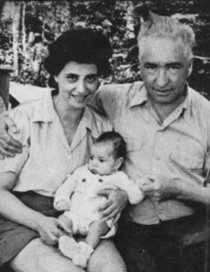
In 1947, Reich was attacked in The New Republic and Harpers in a series of articles written by Mildred Brady, a freelance writer. Jim Martin writes that Michael Straight, a former member of the Cambridge Apostles and friend of some of those involved in the Soviet-Cambridge spy ring, was the publisher of the Brady articles, and that the attack on Reich may have been prompted by Reich's turning his back on Marxism (Martin, 2000). The articles triggered an investigation of Reich by the Food and Drug Administration (FDA), who believed he was peddling a quack cancer cure. Reich had already been investigated by the FBI because he was an immigrant with a communist background. According to an FBI press release dated February 25, 2000:
This German immigrant described himself as the Associate Professor of Medical Psychology, Director of the Orgone Institute, President and research physician of the Wilhelm Reich Foundation, and discoverer of biological or life energy. A 1940 security investigation was begun to determine the extent of Reich's communist commitments. In 1947, a security investigation concluded that neither the Orgone Project nor any of its staff were engaged in subversive activities or were in violation of any statute within the jurisdiction of the FBI.
Though cleared of suspicion of subversive activities, the FDA investigation continued. On February 10, 1954, acting on allegations in the Brady articles, they filed a complaint seeking a permanent injunction under the Federal Food, Drug, and Cosmetic Act to prevent interstate shipment of orgone-therapy equipment and literature. Reich refused to appear in court, apparently believing that no court was in a position to evaluate his work. On February 25, he wrote to Judge Clifford:
My factual position in the case as well as in the world of science of today does not permit me to enter the case against the Food and Drug Administration, since such action would, in my mind, imply admission of the authority of this special branch of the government to pass judgment on primordial, pre-atomic cosmic orgone energy."
Because of Reich's failure to appear, Judge Clifford granted the injunction on March 19, 1954. The ruling stated that all written material, including books, papers and pamphlets that mentioned "orgone energy" had to be destroyed, and that further copies of Reich's books could not be published, including his revised classics like The Mass Psychology of Fascism, unless the words "orgone energy" were deleted.
Imprisonment and death
In May 1956, Reich was arrested for technical violation of the injunction when an associate moved some orgone-therapy equipment across a state line, and Reich was charged with contempt of court. Once again, he refused to arrange a legal defense. He was brought in chains to the courthouse in Portland, Maine. Representing himself, he admitted to having violated the injunction and arranged for the judge to be sent copies of his books. He was sentenced to two years' imprisonment.
Dr. Morton Herskowitz, a fellow psychiatrist and friend of Reich's wrote of the trial:
Because he viewed himself as a historical figure, he was making a historical point, and to make that point he had conducted the trial that way. If I had been in his shoes, I would have wanted to escape jail, I would have wanted to be free, etc. I would have conducted the trial on a strictly legal basis because the lawyers had said, "We can win this case for you. Their case is so weak, so when you let us do our thing we can get you off." But he wouldn't do it.
On June 5, 1956, FDA officials traveled to Orgonon, Reich's 200-acre (80-hectare) estate near Rangeley, Maine, where they destroyed the accumulators, and on June 26, burned many of his books. On August 25, 1956 and again on March 17, 1960, the remaining six tons of his books, journals and papers were burned in the 25th Street public incinerator in New York's lower east side (Gansevoort incinerator). In March 1957, he was sent to Danbury Federal Prison.
Reich died in his sleep of heart failure on November 3, 1957 in the federal penitentiary in Lewisburg, Pennsylvania, one day before he was due to apply for parole. He was buried in Orgonon. At his own instruction, his granite headstone said simply:
Reich had developed engines that ran on free energy, and that was the main reason the goverment wanted to stop him. He could therfore have been murded in prison one day prior to his realease to prevent futher researce by him on free energy.
Not one psychiatric or established scientific journal carried an obituary. Time Magazine noted:
Died. Wilhelm Reich, 60, once-famed psychoanalyst, associate, and follower of Sigmund Freud, founder of the Wilhelm Reich Foundation, lately better known for unorthodox sex and energy theories; of a heart attack in Lewisburg Federal Penitentiary, Pa; where he was serving a two-year term for distributing his invention, the orgone energy accumulator (in violation of the Food and Drug Act), a telephone-booth-size device which supposedly gathered energy from the atmosphere, and could cure, while the patient sat inside, common colds, cancer and impotence.
Status of Reich's work
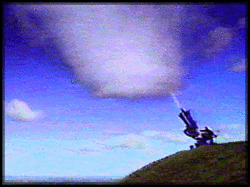
As of 2005, the mainstream scientific community pays little attention to Reich's work, but he is popular in other areas, particularly psychotherapy. Nearly all of his publications have been reprinted, save for his research journals which are available only as photocopies via the Wilhelm Reich Museum. The first editions are not available: Reich continously amended his books throughout his life, and the owners of Reich's intellectual property actively forbid anything other than the latest revised versions to be reprinted. In the late 1960s, the publishing house of Farrar, Straus & Giroux republished Reich's major works. Reich's earlier books, particularly The Mass Psychology of Fascism, are regarded as historically valuable.
William Steig, Norman Mailer, William S. Burroughs, and Orson Bean have all undergone Reich's orgone therapy. In the late 1960s and early 1970s, Reich's ideas on social and sexual freedom enjoyed a revival and most of his books were reprinted and widely read, including by the loosely defined "New Left" and students' movements in Europe and the U.S., though often with considerable distortion of his ideas.
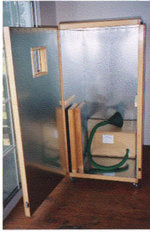
His influence is strongly felt in psychotherapy. He was a forerunner of body-oriented, emotions-based psychotherapies, influencing Fritz Perls' Gestalt therapy and Arthur Janov's primal therapy. See also Neo-Reichian massage. His pupil Alexander Lowen, the founder of bioenergetic analysis, Charles Kelley, the founder of Radix Therapy, and James DeMeo of the Orgone Biophysical Research Laboratory ensure that his research receives widespread attention. Many practising psychoanalysts give credence to his theory of character, and his book Character Analysis is still used as a textbook. The American College of Orgonomy, originally led by Dr. Elsworth Baker, and the Institute for Orgonomic Science led by Dr. Morton Herskowitz, still use Reich's original therapeutic methods. Research into Reich's biophysics continues, by scientists working in a small number of private institutions mostly in the USA and Europe.
Reich's life and work continue to influence popular culture, with references to orgone and cloudbusting found in songs by Clutch, Hawkwind, Pop Will Eat Itself, Turbonegro and Patti Smith. Kate Bush's song, "Cloudbusting," describes Reich's arrest and incarceration through the eyes of Reich's son, Peter, who wrote his father's story in A Book of Dreams, published in 1973. Frank Zappa was also influenced by Reich's work. The philosopher and science fiction author Robert Anton Wilson wrote a play, Wilhelm Reich in Hell, based on his life.
Bibliography
Information about todays orgon equipment and researce can be found at http://www.orgonise-africa.net
Books by Wilhelm Reich
- Der triebhafte Charakter : eine psychoanalytische Studie zur Pathologie des Ich, 1925
- Die Funktion des Orgasmus : zur Psychopathologie und zur Soziologie des Geschlechtslebens, 1927
- Ueber den Oedipuskomplex : drei psychoanalytische Studien with Felix Boehm and Otto Fenichel, 1931
- Character analysis or in the original: Charakteranalyse : Technik und Grundlagen für studierende und praktizierende Analytiker, 1933
- Massenpsychologie des Faschismus, 1933, original German edition, banned by the Nazis and the Communists.
- The Mass Psychology of Fascism, 1946 revised and enlarged U.S. edition
- Die Sexualitaet im Kulturkampf, 1936 U.S. edition 1945 The Sexual Revolution
- Dialektischer Materialismus und Psychoanalyse, 1929
- Der Einbruch der Sexualmoral, 1932
- Die Sexualitaet im Kulturkampf, 1936
- Die Bione, 1938
English-language books by Reich:
- American Odyssey:Letters and Journals 1940-1947
- Beyond Psychology:Letters and Journals 1934-1939
- The Bioelectrical Investigation of Sexuality and Anxiety
- The Bion Experiments: On the Origins of Life
- Function of the Orgasm (Discovery of the Orgone, Vol.1)
- The Cancer Biopathy (Discovery of the Orgone, Vol.2)
- Character Analysis
- Children of the Future: On the Prevention of Sexual Pathology
- Contact With Space: Oranur Second Report
- Cosmic Superimposition: Man's Orgonotic Roots in Nature
- Early Writings
- Ether, God and Devil
- Genitality in the Theory and Therapy of Neuroses
- The Invasion of Compulsory Sex-Morality
- Listen, Little Man!
- Mass Psychology of Fascism
- The Murder of Christ (Emotional Plague of Mankind, Vol.2)
- The Oranur Experiment
- The Orgone Energy Accumulator, Its Scientific and Medical Use
- Passion of Youth: An Autobiography, 1897-1922
- People in Trouble: Emotional Plague of Mankind, Vol.1)
- Record of a Friendship: The Correspondence of Wilhelm Reich and A.S. Neill (1936-1957)
- Reich Speaks of Freud
- Selected Writings: An Introduction to Orgonomy
- The Sexual Revolution
About Reich and his findings, by various authors
- Albini, Carlo: Creazione & Castigo: La Grande Congiura Contro Wilhelm Reich, Tre Editori, Roma 1998.
- Baker, Elsworth F.: Man In The Trap, Macmillan, NY, 1967.
- Bean, Orson: Me And The Orgone, St. Martin's Press, NY, 1971.
- Boadella, David: Wilhelm Reich, The Evolution Of His Work, Henry Regnery, Chicago, 1973.
- Boadella, David (Ed.): In The Wake Of Reich, Coventure, London, 1976.
- Brady, Mildred Edie, "The Strange Case of Wilhelm Reich," New Republic, May 26, 1947
- ___________________ "The New Cult of Sex and Anarchy," Harper's, April 1947.
- Cantwell, Alan, "Dr. Wilhelm Reich: Scientific Genius or Medical Madman New Dawn Magazine, May-June 2004
- DeMeo, James: "The Orgone Accumulator Handbook: Construction Plans, Experimental Use and Protection Against Toxic Energy, Natural Energy Works, Ashland, Oregon 1989.
- DeMeo, James (Ed.): "On Wilhelm Reich And Orgonomy (Pulse of the Planet #4), Natural Energy Works, Ashland, Oregon 1993.
- DeMeo, James: "Saharasia: The 4000 BCE Origins of Child-Abuse, Sex-Repression, Warfare and Social Violence, In the Deserts of the Old World, Natural Energy Works, Ashland, Oregon 1998.
- DeMeo, James & Senf, Bernd (Eds.): Nach Reich: Neue Forschungen zur Orgonomie: Sexualokonomie, Die Entdeckung Der Orgonenergie (After Reich: New Research in Orgonomy: Sex-Economy, Discovery of the Orgone Energy), Zweitausendeins Verlag, Frankfurt, 1998.
- DeMeo, James (Ed.): "Heretic's Notebook: Emotions, Protocells, Ether-Drift and Cosmic Life Energy, With New Research Supporting Wilhelm Reich, Natural Energy Works, Ashland, Oregon 2002.
- Eden, Jerome: Orgone Energy, The Answer To Atomic Suicide, Exposition, NY, 1972.
- Eden, Jerome: Animal Magnetism And The Life Energy, Exposition, NY, 1974.
- Greenfield, Jerome: Wilhelm Reich Vs. The USA, W.W. Norton, NY, 1974.
- Herskowitz, Morton: Emotional Armoring: An Introduction to Psychiatric Orgone Therapy, Transactions Press, NY 1998.
- Hoppe, Walter: Wilhelm Reich Und Andere Grosse Manner Der Wissenschaft Im Kampf Mit Dem Irrationalismus (Wilhelm Reich and Other Great Men of Science in the Battle Against Irrationalism), Verlag Kurt Nane Jurgensen, Munich, 1985.
- Laska, Bernd A.: Sigmund Freud contra Wilhelm Reich Auszug aus Laska, Bernd A.: Wilhelm Reich. Bildmonographie. Rowohlt, Reinbek 1981, 1999
- Mann, Edward: Orgone, Reich And Eros: Wilhelm Reich's Theory Of The Life Energy, Simon & Schuster, NY, 1973.
- Mann, Edward & Hoffman, Ed: The Man Who Dreamed Of Tomorrow: A Conceptual Biography Of Wilhelm Reich, J.P. Tarcher, 1980.
- Martin, Jim: Wilhelm Reich and the Cold War, Flatland Books, Mendocino, CA, 2000.
- Meyerowitz, Jacob: Before the Beginning of Time, rRp Publishers, Easton, PA 1994.
- Moise, William S.: A Taste Of Color, A Touch Of Love, Hancock, Maine, 1970.
- Ollendorff, Ilse: Wilhelm Reich: A Personal Biography, St. Martin's Press, NY, 1969.
- Overly, Richard: Gentle Bio-Energetics: Tools for Everyone, Gentle Bioenergetics Press, Asheville, NC, 1998.
- Raknes, Ola: Wilhelm Reich And Orgonomy, St. Martin's Press, NY, 1970; Penguin, Baltimore, 1970.
- Reich, Peter: A Book Of Dreams, Harper & Row, NY, 1973.
- Ritter, Paul, Ed.: Wilhelm Reich Memorial Volume, Ritter Press, Nottingham, England, 1958.
- Sharaf, Myron: Fury On Earth: A Biography Of Wilhlem Reich, St. Martin's-Marek, NY, 1983.
- Senf, Bernd: Die Wiederentdeckung des Lebendigen (The Rediscovery of the Living), Zweitausendeins Verlag, Frankfurt, 1996.
- Wilson, Robert Anton: Wilhelm Reich in Hell, Aires Press, 1998.
- Wyckoff, James: Wilhelm Reich: Life Force Explorer, Fawcett, Greenwich, CT, 1973.
The Einstein experiments
- Wilhelm Reich, The Einstein Affair, 1953
- Correa, P & Correa, A (1998, 2001) "The thermal anomaly in ORACs and the Reich-Einstein experiment: implications for blackbody theory", Akronos Publishing, Concord, ON, Canada, ABRI monograph AS2-05.
- Correa PN & Correa AN (2001) "The reproducible thermal anomaly of the Reich-Einstein experiment under limit conditions", Infinite Energy, 37:12.
- Mallove, E (2001) "Breaking Through: A Bombshell in Science", Infinite Energy, 37:6.
- Mallove, E (2001) "Breaking Through: Aether Science and Technology", Infinite Energy, 39:6.
- Aspden, H (2001) "Gravity and its thermal anomaly: was the Reich-Einstein experiment evidence of energy inflow from the aether?", Infinite Energy, 41:61.
- Bearden, T (2002) "Energy from the vacuum", Cheniere Press, Santa Barbara, CA, pp. 333-337.
- References in Einstein biographies:
- Ronald W. Clark, Einstein: The Life and Times, New York: Avon, 1971, ISBN 038001159X Reich on pages 689-90 paperback edition.
- Denis Brian, Einstein: A Life, John WIley, 1996, ISBN 0471114596 Reich discussed on pages 325-327, 382, 399
